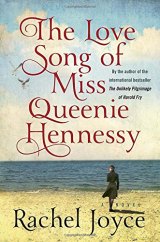Review: Rachel Joyce’s The Love Song of Miss Queenie Hennessy
 9/7/15 – Rachel Joyce, Harold Fry and Queenie Hennessey
9/7/15 – Rachel Joyce, Harold Fry and Queenie Hennessey
Lately I’ve been reading a lot of sequels, and even a few prequels, because I’m working on a sequel of my own. I’ve also been reading a lot of books with older protagonists because my main character is in his seventies. So it was no surprise that I picked up Rachel Joyce’s The Love Song of Miss Queenie Hennessy, a follow-on to her enchanting best seller of 2012, The Unlikely Pilgrimage of Harold Fry. The principal characters are the same and the new novel is in many ways another chapter of the story, but it is neither a prequel nor a sequel. It’s an “equel.”
The first novel tells the story of Harold Fry, a retired brewery sales rep living a quiet life in a less-than-perfect marriage when he receives a letter from an old colleague and friend, Queenie Hennessy, whom he hasn’t seen in 20 years. They were once close, so close that when Harold went off his head after the death of his son and wrecked his boss’s office, Queenie stepped in and took the blame, saving Harold’s job. She soon left town and now lives on the other side of England, with Harold still unaware of her unrequited love for him, let alone her creation of a sea garden that pays homage to him.
Queenie has reached out to Harold to say goodbye because she’s dying of cancer. He writes a modest note in return and sets off to mail it, but he passes one mailbox after another until he decides he’s going to keep walking and deliver the letter in person. Never mind that Queenie is 600 miles away or that he has no plan, no change of clothes, and is wearing yachting shoes. He calls the hospice where Queenie is staying and leaves a message for her: “Wait for me.”
It’s the makings of a delightful story and in Joyce’s accomplished hands, it became a remarkable novel, longlisted for the Booker Prize and an international best seller.
As she made the rounds to promote the book, readers and interviewers kept asking Joyce if a sequel was planned. She said no, she never had any intention of doing that. Then she realized that something was missing.
 The first book told readers very little about Queenie’s side of the story and eventually Joyce set out to fix that. The second book, which she prefers to call a companion to the first, takes place in Queenie’s hospice—and in her memory—during the time that Harold is on his journey. It helps that in the first book, Harold won the attention of the national media, which in turn allows all of the residents in the hospice to follow his walk on TV. In short order, they begin to feel that he is coming to see them as much as his old friend, and they, too, try to hold on until he arrives, with mixed success. Queenie decides to use the time to dictate a letter to Harold, which fills in a good deal of her history, both for readers and, tellingly, for Harold.
The first book told readers very little about Queenie’s side of the story and eventually Joyce set out to fix that. The second book, which she prefers to call a companion to the first, takes place in Queenie’s hospice—and in her memory—during the time that Harold is on his journey. It helps that in the first book, Harold won the attention of the national media, which in turn allows all of the residents in the hospice to follow his walk on TV. In short order, they begin to feel that he is coming to see them as much as his old friend, and they, too, try to hold on until he arrives, with mixed success. Queenie decides to use the time to dictate a letter to Harold, which fills in a good deal of her history, both for readers and, tellingly, for Harold.
Each novel stands on its own, but each also adds meaning and depth to the other. This second book, though, is altogether different from the first. Both are rich in insight, mixing human foibles and life tragedies with humor, but Queenie’s story carries much more of a burden. On the one hand, Queenie’s life story is a sad tale of missed opportunities. And on the other, describing life in a hospice without invoking a reader’s pity is a huge challenge. The risk is that the story will be either very depressing or unbelievably upbeat. Joyce somehow manages to find the right balance. She makes us care deeply about all of the characters—Queenie, Harold, the nuns and volunteers who work in the hospice, and the other patients struggling to come to terms with their imminent deaths—without straining credulity or leaving us unbearably sad. The feelings I had when I finished the novel made me think of how I have felt when I’ve been able to say goodbye to a loved one by celebrating that person’s accomplishments, mitigating the loss of their presence.
Joyce, who’s 53, also has an understanding of older people, including the dying, and how to write about them. It’s something I’ve struggled with since an agent in her twenties looked at my query letter and exclaimed, “Your protagonist is 72? No one wants to read about an old man. Can’t you make him twenty years younger?” Well, no, and in the new book, he’s 74.
There are of course thousands of great works about older people—from King Lear to Old Filth—but suffice it to say, that in Joyce’s hands, older protagonists show a wisdom, an ability to look back and find meaning, a sense of humor, an appreciation for life, an understanding of people and human nature, and a reckoning with life’s tragic moments. That’s what makes Joyce’s companion novel so valuable to readers and it’s why any writer would do well to emulate her.
Mark Willen
Mark Willen’s novels, Hawke’s Point, Hawke’s Return, and Hawke’s Discovery, were released by Pen-L Publishing. His short stories have appeared in Corner Club Press, The Rusty Nail. and The Boiler Review. Mark is currently working on his second novel, a thriller set in a fictional town in central Maryland. Mark also writes a blog on practical, everyday ethics, Talking Ethics.com.
- Web |
- More Posts(48)